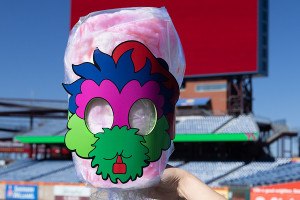Emmanuelle’s New Drinks
Modest innovation—that’s the key to the success of a cocktail bar. Always keep improving, always keep things new and fresh, but don’t be overzealous. Don’t try too hard. There’s a fine line differentiating the two, and with a pho-spiced cocktail, Emmanuelle’s flirting with that line.
But I want it.
The Northern Liberties cocktail bar has a new, exciting, and vulgar spring menu, and they want you to get drunk off it.
New Shit Has Come to Light
house originals ($12)
Shaken
Satyricon
American Dry Gin, dry curaçao, carrot-ginger-red bell pepper syrup, fresh lemon, cardamom & cinnamon tinctures.
This tart refresher stimulates the appetite, awakens the senses, and provides satisfaction, but it’s far better for you than Roman feasts of old that did the same.
Two Weeks from Everywhere
Gold Rhum, Jamaica Rum, pineapple syrup, orgeat, fresh lime, falernum, Bitterman’s Elemakule Tiki bitters.
You shall be transported to a geographical oddity that is at once Martinique, Jamaica, and Hawaii; and isn’t nearby any of them.
Worthy Fucking Adversary
Vodka (or Gin), fresh lime, pho spice syrup, Viet herb blend. Sriracha float optional.
Ever been in a ph? joint finishing up when, suddenly, you crave a gimlet?
White Light White Heat
Vodka, lemongrass syrup, almond milk, fresh lime, habanero-serrano tincture.
A clean but velvety burst of layered refreshment with a restrained fiery note.
Tubarão… Tubarão
Cachaça, Campari, fresh grapefruit, lemon peel oleo-saccharum, egg white, rosewater.
To read this assemblage of ingredients may disorient and startle, much like a Brazilian shark encounter. When the first sip has passed, you breathe a sigh of relief and feel like you’ve gotten away with something.
Baberaham Lincoln
Blended Scotch, Aperol, crème de Mure, fresh lemon, absinthe.
Much like Bohemian Rhapsody, this drink is strong, tart & bittersweet, with a cool finish.
Fickt nicht mit dem Raketemensch
Bonded bourbon, black walnut liqueur, strawberry preserves, balsamic gastrique, Lambrusco, Angostura bitters.
Here’s a fresh-faced, plain-speaking young American suddenly enmired in the maelstrom of the Old World, kinda like that old Greatest Generation.
Stirred
Presuming Ed
Sage spirit, yellow Chartreuse, house celery tonic, fresh lemon.
This tall sipper takes the conventional g & t and bends its brain with unorthodox ideas.
A More Gentlemanlike Manner
100% Torrontel Pisco, Amaro Meletti, Dolin blanc vermouth, Elmegirab’s dandelion & burdock bitters, sparkling wine.
It comes off as frightfully aristocratic, but reveals the earthiness and florality of a carriage trip through the countryside.
Ranger from the North
Akvavit, Batavia Arrack, crème de Peche, fresh lemon, coconut water, Kingsfoil bitters.
A memory of lands across the sea lingers in this tall, well-travelled stranger, and he carries within him herb-lore and the power of healing.
Kobayashi Maru
Genever, 100 % Arneis Grappa, Lillet blanc, green pepper jelly, Regan’s no. 6 & Fee’s orange bitters.
Because sometimes to win you have to change the rules of the game.
Peter Guillam
Bonded rye, cognac, Salers aperitif gentiane, dry curaçao, Elmegirab’s Boker’s bitters, Regan’s no. 6 & Fee’s orange bitters.
Like its namesake, this drink hides sensitivity and mellow steadiness behind a bitter, prickly exterior. Or, it’s European fatalism driving too fast in an American coupé.
Quakers with a Vengeance
Bonded rye, rhubarb shrub, ruby port, vanilla & cinnamon tinctures.
The Quakers of the American whale fisheries were about as full of vinegar as a Quaker gets.
All in the Reflexes
Reposado tequila, coffee liqueur, Benedictine, Carpano Antica, smoked salt tincture.
Jack Burton: “…Feel pretty good. I’m not, uh, I’m not scared at all. I just feel kind of… feel kind of invincible.”
History of the World Part Two
classic cocktails ($10)
The world of drinking in England and America, that is. Punch was invented in the fledgling age of Imperialism, as traditional Western European quaffs didn’t stand up to long sea voyages. Punch (more on that below) broke the seal of mixed drinking, and thence we get a slow budding till the 19th Century fairly explodes with new beverages. Back then you would generally plug you favorite spirit into a given preparation, like specifying a protein when you order a burrito. Have at it!
Cocktail (c. 1800, U.S. mid-Atlantic or New England)
The big drinks of 1700’s America were toddy and sling, which were nigh identical, and both served cold or hot to taste. Sugar and dilution (from ice or boiling water) were used to gentle down the cask-strength spirits of the day. The toddy was further graced with gratings of nutmeg. Cocktail arrived at the turn of the century, adding a medicinal veneer to one’s hair of the dog with the addition of bitters.
Spirit, sugar, bitters, lemon peel.
Stirred with ice, or boiling water.
a variation worth trying:
Seelbach Cocktail (c. 1917, Seelbach Hotel, Louisville, KY)
One of the last riffs on the cocktail before Prohibition, this recipe was lost somewhere in that thirteen-year dry stretch. It dwelt in un-sipped obscurity until the slip of paper containing it once again saw daylight in 1995.
Bourbon, curaçao, Peychaud’s & Angostura bitters, sparkling wine.
(Tom) Collins (c. 1860 arrives at Clarendon Hotel, NY)
This drink took England and then America by storm just before the outbreak of our Civil War. It was based on a London recipe (see below) that used Old Tom Gin, a sweeter English style, and that was the most popular version. It was not uncommon to use other spirits.
Spirit, fresh lemon, sugar, sparkling water.
Tall, built on hefty ice cubes.
try the original Collins:
Limmer’s Punch (c. 1820, John Collins, Limmer’s Hotel, London)
The Collins of song and story was “Honest” John Collins, headwaiter at Limmer’s (Conduit St. & Hanover Square). It housed the dingiest clubroom in all London, yet served the flower of aristocracy (service overseas accustomed them to squalor, it seems). John Collins varied his Punch to his patrons, but the choicest contained Old Tom Gin and capillaire, an aromatic sweetener.
Old Tom Gin, fresh lemon, capillaire,
chilled sparkling water, served tall without ice.
Silver Fizz(c. 1880’s)
The fizz shows up around the 1870’s. It is basically a simple version of Limmers’ punch (see above), served the same way without ice. A decade or so later, egg white is being shaken into it, especially at luncheon. A golden fizz takes egg yoke, an imperial takes both, and a diamond fizz replaces the sparkling water with champagne.
Spirit, fresh lemon, sugar, egg white, shaken.
Served without ice. Finished with soda water.
try this fancy modification:
Morning Glory Fizz (c. 1880’s, Harry Johnson, Little Jumbo, Bowery, NY)
Harry Johnson is beloved of bookish barkeeps because he took time to write about his service philosophy. He was beloved of his patrons because he took the time to devise badass drinks, like the Morning Glory Fizz.
Scotch whiskey, sugar, lemon, lime, dash of absinthe.
Shaken, strained, topped with sparkling water.
Daisy (c. 1870)
The Daisy is essentially a Fizz in a hurry, gussied up with dashes of cordial. Some call it a dainty drink, but they’re probably the same some who call quiche unmanly. (Omelet pie? Done and done!) I say it’s strong enough for a man, and pH balanced enough for a woman.
Spirit, sugar, fresh lemon, curaçao (or maraschino),
shaken & served up, finished with sparkling water.
Guess what’s Spanish for daisy:
Margarita (c. 1930’s, Aguas Calientes, Tijuana, MX)
The locals figured out a way to sell lots of tequila to the tourists crossing the river to wet their whistles during Prohibition.
Tequila, curaçao, fresh lime. Shake, served up.
Manhattan (originated c. 1873, Manhattan Club, 26th & Madison, NY)
Its origins are controversial, but one thing is clear: this drink changed the game. Vermouth would prove its mettle in many popular drinks for the subsequent 80-odd years. The original Manhattan was a 50:50 Manhattan, not dissimilar to a modern one that’s made with 80 proof whiskey. We recommend, however, that you fast-forward back to William Schmidt’s 1892 version from his book, The Flowing Bowl.
2 parts Whiskey, 1 part (red) vermouth, dashes bitters, dash absinthe, optional dashes maraschino &/or sugar.
And then there’s this:
Turf Club Cocktail (c. 1880, Turf Club, 26th & Madison, NY. Yep, same building as the Manhattan Club.)
Back in 1873, the house drink at the Manhattan Club made a big splash, inspiring many variations… including a gin version. Whether you call it the Turf Club, the Martinez, the Martine, the Martigny, or the Martini, the proto- Martini was a gin Manhattan.
Equal parts Tom Gin and (red) vermouth, bitters. Stirred & strained.
Emmanuelle [Facebook]


